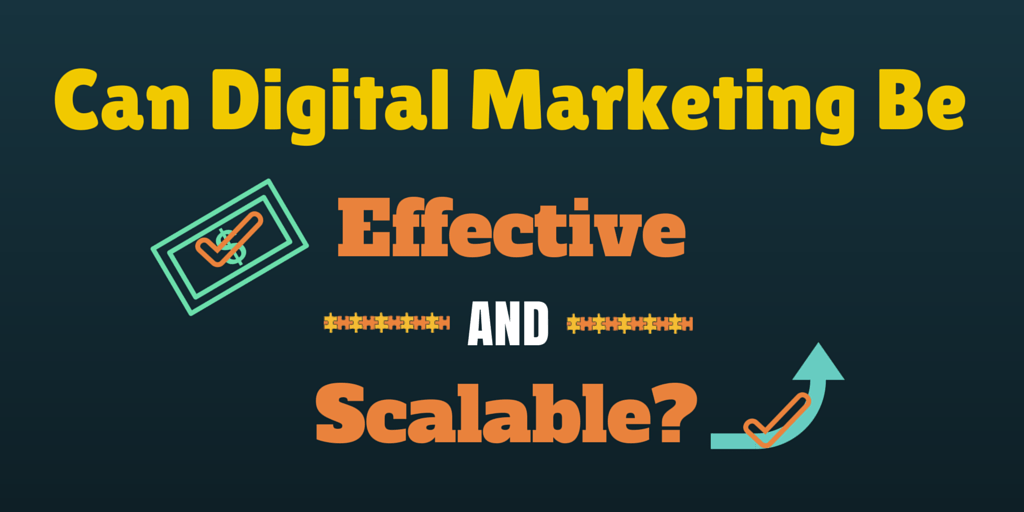Spoiler alert: the answer is “Yes!” But, it takes careful planning and execution in order to make it happen. It also requires us to rethink how we define both “effective” and “scalable” against the backdrop of an ever-changing digital marketing landscape.
What Effective, Scalable Digital Marketing Used to Look Like
Way back in the “olden days” of digital marketing (circa late 90’s, early 2000’s), webmasters and SEO professionals had a much easier job crafting and implementing online strategies that delivered results (improved rankings, increased traffic, etc.). At the time, Google’s algorithms were much less intelligent than they are today, leaving the door wide open for cheap, quick, and easily repeatable marketing tactics.
Keyword stuffing, duplicate content, link networks, and link buying were the name of the game back then. These were things that could be done at scale, and more importantly, were effective at getting results. ‘Quantity over quality’ was the mantra, and “marketers” were buying up any and every link from sites with solid PageRank.
Unfortunately, this began to erode the relevance of SERPS, degrading overall user experience and quickly devaluing any results earned through these practices. The major bombshell came in November of 2003, when Google rolled out their ‘Florida’ algorithm update. Sites who had been ‘gaming’ the system with low-value, spammy tactics saw their rankings plummet, setting the stage for big changes in the way that digital marketing was conducted.
What Effective, Scalable Digital Marketing Looks Like Today
Fast forward to today. We’ve been through a zoo of Google algorithm updates (Panda, Penguin, Pigeon, Hummingbird, etc.), all geared toward improving the quality of search results in one way or another. With these updates, marketing professionals were forced to adopt a ‘quality over quantity’ approach to their online efforts. Instead of buying 1,000 backlinks or duplicating content across multiple publishers, we now focus on crafting mutually beneficial relationships with industry influencers and enhancing those relationships with original, high-quality content in many different mediums.
But how is this new approach to effective digital marketing scalable? This is where the rethinking of how we define “effective” and “scalable” comes in. In the past, we defined “effective” digital marketing as whatever helped to improve rankings and/or drive traffic (i.e. links). “Scalable” meant, ‘the ability to buy, exchange, or otherwise build as many links in as little time as possible.’
Effective Digital Marketing
Today, smart digital marketers know that the effectiveness of their efforts isn’t necessarily measured in rankings or traffic, but rather how those (and many other) metrics affect a company’s business goals. Sure, ranking #1 for a key term is great, but will the benefits of doing so outweigh the time and cost required to get there? Is it better for your brand’s awareness to drive thousands of site visitors via spammy content promotion, or create well-thought, industry leadership type content that might only drive a few hundred relevant visitors to your site?
Rankings and traffic alone are no longer the metrics by which we as digital marketers can hang our hats. To be truly effective, we need to constantly analyze and develop new strategies that align our efforts with the business goals of our clients or employer.
Scalable Digital Marketing
If we’re serious about placing quality of quantity, then scalability becomes less about ‘how much X did we do/build/create this month’ and more about ‘how can we do more of X in the most effective way possible.’ I think there are three primary ways for digital marketers to answer that question:
1) Diversify – This may seem counterintuitive to the principals of scalability, but hear me out. When you diversify your digital marketing strategy, you expand the overall reach that your messaging can have. For example, instead of only utilizing your website to publish and share content, you can incorporate social media promotion, email marketing, and native advertising into the mix to quickly increase the reach of a given marketing message, without much extra effort.
2) Collaborate – Collaboration and diversification work hand in hand. If you’re in charge of digital marketing for a large company, make it point to brainstorm with the PR team, IT department, and graphic design crew. These other teams or experts may be working on something that would fit perfectly with your current idea, opening the door for cross-promotional efforts that increase overall performance.
3) Experiment – You know what one of the most rewarding things about being a digital marketer is? Developing an idea for a new strategy or marketing tactic, having it work like gangbusters, and thinking ‘Holy s#%$^, we need to keep doing this!’ If you always implement the same tactics in the same way across the same channels, you’re going to get the same results. Scalability is about finding new ways to increase your online reach without exponentially increasing the work involved. Experimentation is how you identify those new tactics.
This article was originally published on Business2Community.com
